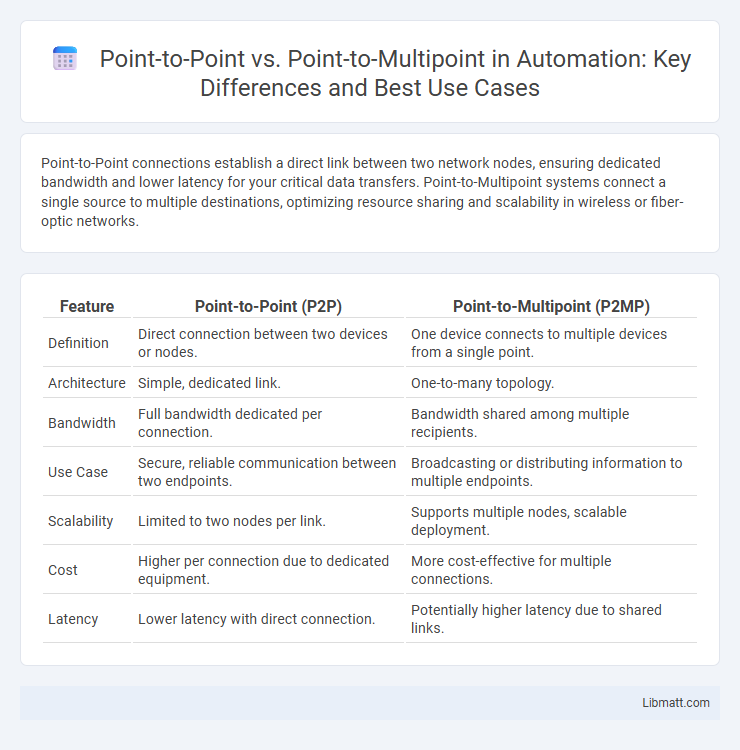Point-to-Point connections establish a direct link between two network nodes, ensuring dedicated bandwidth and lower latency for your critical data transfers. Point-to-Multipoint systems connect a single source to multiple destinations, optimizing resource sharing and scalability in wireless or fiber-optic networks.
Table of Comparison
| Feature | Point-to-Point (P2P) | Point-to-Multipoint (P2MP) |
|---|---|---|
| Definition | Direct connection between two devices or nodes. | One device connects to multiple devices from a single point. |
| Architecture | Simple, dedicated link. | One-to-many topology. |
| Bandwidth | Full bandwidth dedicated per connection. | Bandwidth shared among multiple recipients. |
| Use Case | Secure, reliable communication between two endpoints. | Broadcasting or distributing information to multiple endpoints. |
| Scalability | Limited to two nodes per link. | Supports multiple nodes, scalable deployment. |
| Cost | Higher per connection due to dedicated equipment. | More cost-effective for multiple connections. |
| Latency | Lower latency with direct connection. | Potentially higher latency due to shared links. |
Introduction to Point-to-Point and Point-to-Multipoint
Point-to-Point (PtP) communication establishes a direct, dedicated link between two nodes, ensuring high-speed, low-latency data transmission ideal for backhaul connections and secure data transfer. Point-to-Multipoint (PtMP) networks connect a single central node to multiple endpoints, optimizing resource allocation and reducing infrastructure costs for broadband access and wireless internet service providers. Both architectures serve different network topologies, with PtP offering exclusive connectivity and PtMP enabling scalable distribution of network resources.
Core Concepts: Defining P2P and P2MP Architectures
Point-to-Point (P2P) architecture establishes a direct, dedicated connection between two network nodes, enabling high-speed, secure, and low-latency data transfer. Point-to-Multipoint (P2MP) architecture links a single central node to multiple endpoints, optimizing resource use and expanding network reach for broadcasting or distribution applications. P2P suits scenarios requiring exclusive, uninterrupted communication, while P2MP efficiently supports IoT deployments, wireless access points, and multicast transmissions.
Network Topology Comparison
Point-to-Point (PtP) topology establishes a direct link between two network nodes, offering high bandwidth and low latency ideal for dedicated communication channels. In contrast, Point-to-Multipoint (PtMP) topology connects one central node to multiple endpoints, optimizing resource distribution and scalability but potentially introducing increased latency and bandwidth contention. Network architects select PtP for secure, high-performance connections, while PtMP suits cost-effective, wide-area deployments serving numerous clients.
Performance and Bandwidth Considerations
Point-to-Point connections provide dedicated bandwidth between two locations, ensuring consistent high performance ideal for latency-sensitive applications and large data transfers. In contrast, Point-to-Multipoint setups share bandwidth among multiple endpoints, which can lead to variable performance and potential bottlenecks during peak usage. Understanding these differences helps you optimize network design based on your bandwidth demands and performance requirements.
Scalability: Expansion and Future-Proofing
Point-to-Multipoint (PtMP) architectures offer superior scalability compared to Point-to-Point (PtP) systems due to their ability to serve multiple endpoints from a single hub, reducing infrastructure costs and simplifying network expansion. Your network can easily accommodate growing device counts and evolving bandwidth requirements with PtMP, making it more future-proof for dynamic environments. In contrast, PtP setups require additional dedicated links for each new connection, leading to higher costs and complexity as the network scales.
Cost Implications and Deployment Complexity
Point-to-point networks typically incur higher initial costs due to dedicated hardware and direct connection requirements but offer simpler network management with fewer nodes. In contrast, point-to-multipoint systems reduce infrastructure expenses by sharing a single transmission point among multiple receivers, though they introduce increased deployment complexity through the need for careful signal distribution and interference management. Evaluating total cost of ownership involves balancing upfront investment against scalability and maintenance demands unique to each topology.
Use Cases: Ideal Scenarios for P2P and P2MP
Point-to-Point (P2P) connections are ideal for scenarios requiring high-speed, dedicated links between two locations, such as linking data centers or providing private network access for remote offices. Point-to-Multipoint (P2MP) configurations suit environments where multiple endpoints need to connect to a central hub, commonly used in wireless internet service providers offering broadband to several subscribers. Understanding your network's demand for direct connections versus shared access helps determine whether P2P or P2MP technology best supports your communication infrastructure.
Security Aspects in Both Network Types
Point-to-point (PtP) networks offer enhanced security by establishing a dedicated communication link between two devices, limiting exposure to unauthorized access and reducing the risk of data interception. In contrast, point-to-multipoint (PtMP) networks connect multiple endpoints to a single central node, increasing vulnerability due to shared communication channels and the need for robust encryption protocols and access controls. Implementing advanced authentication mechanisms and end-to-end encryption is critical in PtMP setups to mitigate potential security threats and maintain data integrity across all connected devices.
Advantages and Disadvantages: A Side-by-Side View
Point-to-Point (PtP) connections provide a dedicated communication link between two endpoints, offering high security, low latency, and consistent bandwidth ideal for critical data transfer. Point-to-Multipoint (PtMP) systems enable a single transmitter to communicate with multiple receivers, maximizing coverage and cost-efficiency but potentially facing interference and reduced performance with increasing connected devices. Choosing between PtP and PtMP depends on your network's scalability, reliability requirements, and budget constraints.
Choosing the Right Solution: Key Decision Factors
Choosing the right solution between Point-to-Point (PtP) and Point-to-Multipoint (PtMP) involves evaluating factors such as network size, bandwidth requirements, and cost efficiency. PtP is optimal for dedicated, high-capacity links between two locations, while PtMP supports multiple endpoints with cost-effective scalability. Consider your network's expansion plans and reliability needs to ensure your infrastructure aligns with performance goals.
Point-to-Point vs Point-to-Multipoint Infographic

 libmatt.com
libmatt.com